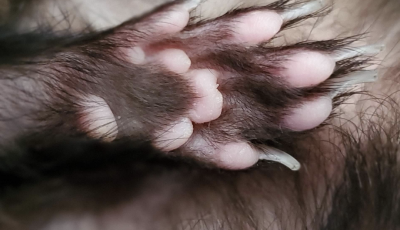
Did you know that in the United States, ferrets are the third most popular pet after cats and dogs?

And if you didn’t know what they can do, you would find ferret feet cute with their soft pink pads and almost human-like dexterity. Ferret paws have a high degree of mobility and fine motor control, and indeed, are capable of grasping and manipulating objects with precision. Ferret feet are well endowed with touch receptors, useful to curious critters who use their paws to handle and examine items. It’s an endearing trait to a pet ferret owner. Not so much to a rabbit being hunted by the mustelid.
The use of ferrets in hunting dates back centuries. The carnivorous mammal was so effective that it became one of the most popular hunting companions in many parts of Europe, ferret hunting becoming an important pastime for nobles. Itself a predator, a ferret possesses innate instincts that makes him an effective hunter. A long, slender body enables him to chase after prey through the tight space of a burrows or underground tunnel, plus, a ferret could be trained to hunt rabbits, rats, and other small game, its speed, agility, and fearlessness widely admired.
The island country of Malta historically used ferrets to hunt rabbits in its coralline limestone terrain of rocky ridges, valleys, and promontories.
People native to the country, the Maltese, didn’t rely solely on ferrets to hunt, however, they partnered ferrets with another mammal with interesting feet, the Pharaoh Hound. When the hound located a rabbit, the rabbit took off seeking refuge in den in the ground or a hole in a wall. Once cornered, all possible exits for the rabbit were covered with nets, and out came a ferret. Wearing a tiny bell around his neck, the ferret was set in the hole the rabbit just entered, his task to bolt the rabbit out of his hiding place, and into a hunter’s net. Though not a happy outcome for the rabbit, the results fed a family that night.
We segue to dogs, and hounds, in particular. Hound people tend to know better than many the importance of feet to a hound. In many breeds, a hound’s padded feet is its “running gear,” its stock in trade, so to speak, that enables the dog to withstand hours of walking, running, and traversing various types of terrain. In others, strong claws and big front feet allow the dog to dig and excavate burrows to reach their quarry. And for others, feet provide traction and stability, allowing the dog to make quick turns, change directions, and maintain balance while in pursuit.
The feet of the Pharaoh Hound have been a critical factor in the breed’s survival. We find it interesting to note that like its traditional hunting companion in Malta, the ferret, a Pharaoh Hound’s foot is used like a hand to grip rough terrain. The parent club’s Illustrated Standard writes that “grasping toes and nails are necessary for climbing,” and that often, when reaching for an object, the Pharaoh Hound will “spread his toes, using his foot as though it were a hand.”
Indeed, on less stable surfaces like sand or gravel, a Pharaoh Hound foot will spread slightly to give the dog more control. Had it not been for the dexterity of its “cat-footed-ness,” the Pharaoh Hound could not have survived in its country of origin.
Image: “King’s Treasure” by Cori Solomon
http://corispawtraits.com
http://arthelpinganimals.blogspot.com
